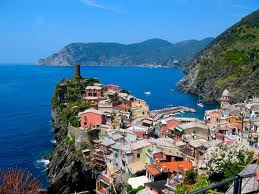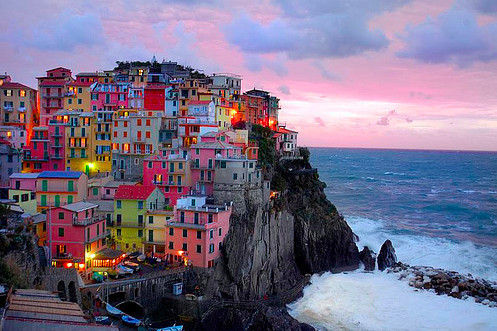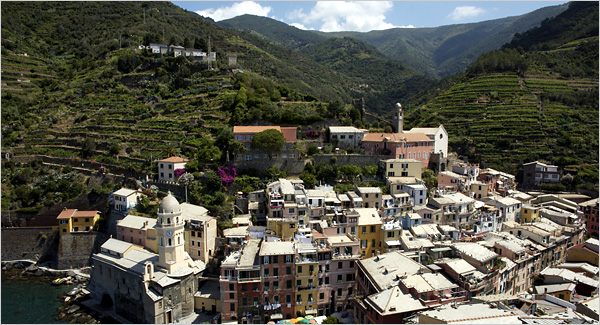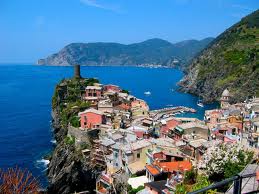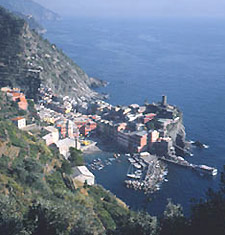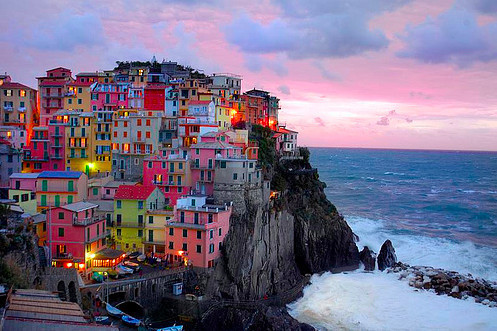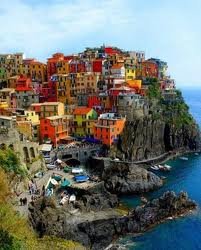A Traveler’s History of the Cinque Terre
 A Traveler’s History of the Cinque Terre
A Traveler’s History of the Cinque Terre
Nestled along the coast, idyllic Vernazza was once prone to pirate attacks.
Nestled along the coast, idyllic Vernazza was once prone to pirate attacks.
It’s a sunny afternoon a thousand years ago in the Cinque Terre (CHINK-weh TAY-reh), long before it became the Italian Riviera. This string of humble villages, surrounded by terraced vineyards, is a two-day sail from Genoa.
The leathery old farmer, taking a break from tending his grape vines, picks a cactus fruit to quench his thirst. Suddenly howls come from the crude stony tower crowning a bluff that marks his village of Vernazza. Turkish pirates are attacking.
Avoiding powerhouse cities like nearby Genoa and Pisa, pirates delight in the villages. These Cinque Terre towns, famous since Roman times for their white wine, are like snack time for rampaging pirates. Villagers run for cover down corridors buried deep in the clutter of homes that clog Vernazza’s ravine.
A thousand years later, another leathery grape-picker is startled by the roar of a smoke-billowing train. Emerging from the newly built tunnel, it flies a red, white and green flag. It’s 1870 and the feudal and fragmented land of Italy is finally united. This first Italian train line, an engineering triumph of fledgling Italy, laced together Turin, Genoa, Rome…and, by chance, tiny Vernazza.
Decades later, in the 1930s, an Italian dictator teams up with a German tyrant. The war they started is going badly. In 1943 the German Führer calls on Vernazza’s teenage boys to report for duty. The boys, who are assured they’ll only work in German farms and factories, know they’ll end up as fodder on the front. Rather than dying for Hitler, they become resistance fighters. Running through the night, they climb the ancient terraces like giant stairsteps into the hills high above the village cemetery.
The 1970s bring on a different battle scene. Hippies exercise their right to lay naked on the Cinque Terre’s remote Guvano beach. Outraged, an angry armada of villagers — fully clothed and accompanied by a raft of reporters — converge on the ratpack of sunburned big-city hedonists. Conservative little Vernazza makes headlines across Italy.
Next, the age of tourism arrives. In 1978 a college-aged American backpacker, stumbling onto the region, finds the traditions vivid, the wine cheap, and the welcome warm. Inspired by the Cinque Terre and similar places throughout the Continent, he declares the region a “back door” and writes what will become a top-selling guidebook on Europe.
By the 1990s, word of this paradise is out. More and more travelers visit — staying in local apartments rather than in hotels. One day, at the crack of dawn, another invasion comes…this time by land. A platoon of Italian tax inspectors blitz the sleepy town, rousting out the tourists and cornering locals renting unlicensed rooms. B&B income in Vernazza is suddenly no longer tax-free.
Today gnarled old men still tend their grapevines. Now Vernazza’s castle — named “Belforte” centuries ago for the screams of its watchmen — protects only glorious views. And the screams ringing out are of delight from children playing on the beach below.
But the local economy has changed. The poor village is now a rich village, living well in its rustic and government-protected shell. Tourism drives the economy as the less-calloused locals feed and house travelers. While the private rooms rented are basic, the cuisine — super-charged by a passion for pasta, pesto, and seafood — is some of Italy’s best.
By: Rick Steves


